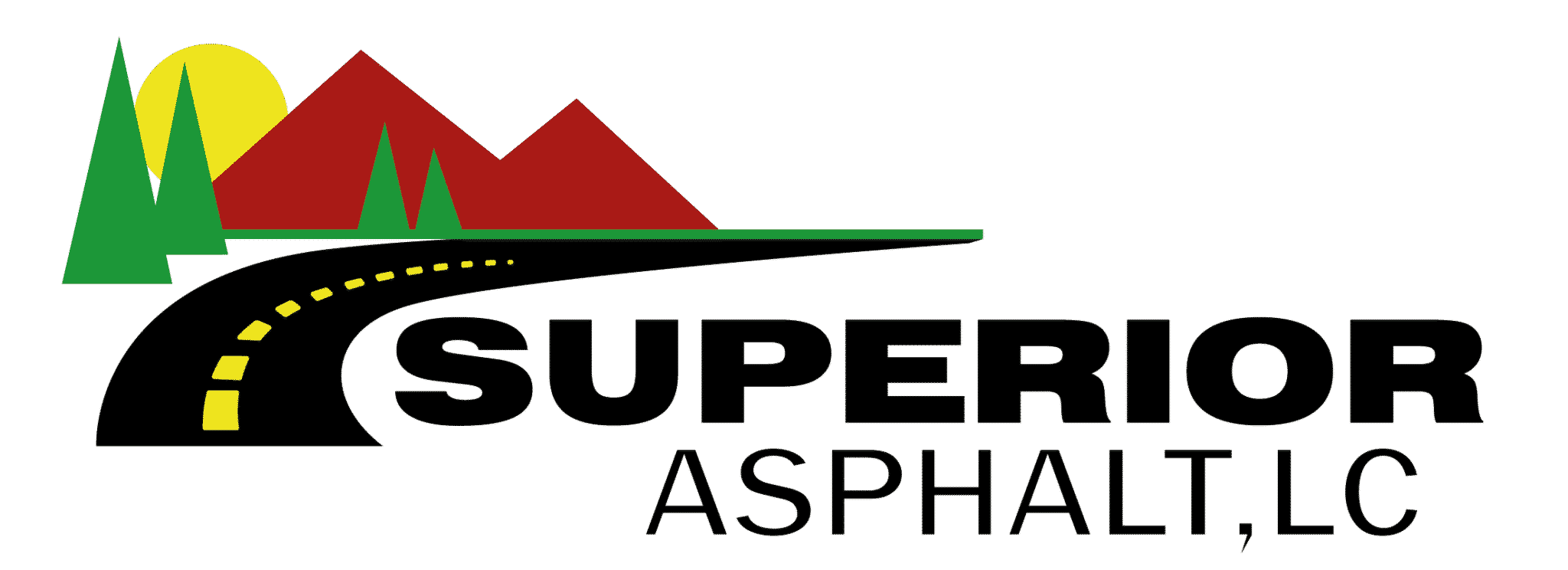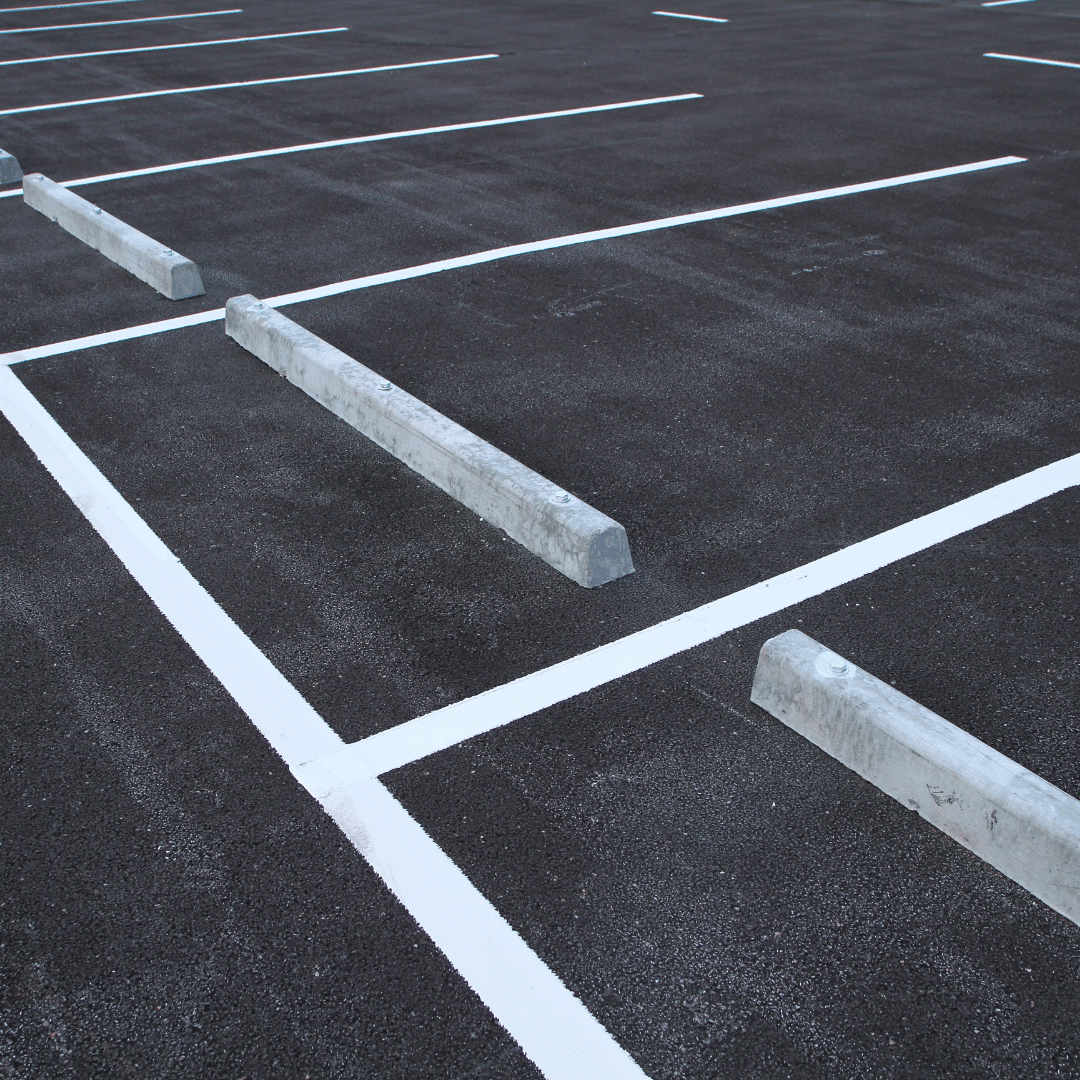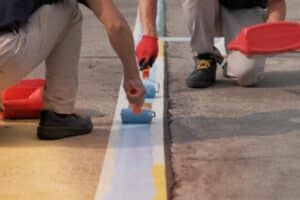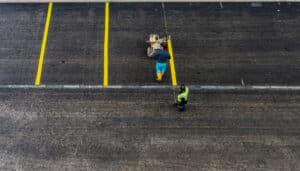There are a few telltale signs that it’s time to restripe your parking lot lines: faded paint, incorrect markings, and an overall appearance that is in disrepair. But what does restriping involve exactly? And why is it necessary? In this article, we’ll discuss the basics of restriping parking lot lines and answer some common questions about the process.
The Importance of Parking lot Restriping
Restriping parking lot lines is essential for a few reasons. First, it ensures that your property complies with local regulations. In many municipalities, there are strict guidelines about how parking lots must be marked. For example, handicap-accessible spaces must be clearly designated, and fire lanes must be kept clear at all times. Restriping your parking lot lines is the best way to ensure that your property is in compliance with all local regulations.
Second, restriping your parking lot lines can help improve your property’s safety. Well-marked parking lots are less likely to experience accidents and injuries. Restriping can also help prevent damage to vehicles by clearly marking curbs, fire hydrants, and other obstacles.
Finally, restriping your parking lot lines is a great way to improve the overall appearance of your property. Faded or incorrect markings can make your property look unprofessional and neglected. A fresh coat of paint can give your property an instant facelift and make it more inviting to customers and guests.
How Often Should You Restripe Your Parking Lot Lines?
Most experts recommend restriping your parking lot lines every one to three years, depending on the amount of traffic your property receives. For example, if you have a high traffic volume, you may need to restripe your parking lot lines more frequently. In addition, if your property is in a location with harsh weather conditions, you may also need to restripe more often to maintain the quality of the paint job.
When Should You Restripe Your Parking Lot?
While it’s key to restripe every couple of years, there are a few specific situations when restriping is particularly important:
- After repaving: If you’ve had your parking lot repaved, it’s essential to restripe the lines as soon as possible. This will ensure that your parking lot is appropriately marked and compliant with all local regulations.
- After making changes: If you’ve made changes to your parking lot (such as adding or removing parking spaces), restriping is necessary to ensure that your changes are reflected in the markings.
- After an accident: If there’s been an accident in your parking lot, restriping can help prevent future accidents by making the lines and markings more visible.
- When selling your property: If you’re selling your property, restriping is a great way to improve its curb appeal and make it more attractive to potential buyers.
These are generally the most common times when restriping is needed, but it’s always a good idea to consult a professional to get their expert opinion.
Why Do Asphalt Stripes Deteriorate?
All parking lots go through a natural process of deterioration, even if they’re well-maintained. Over time, the natural environment, traffic flow, and other factors will cause the stripes to fade, chip, and crack. Sometimes, you may need to restripe your parking lot more frequently to combat this deterioration.
A few common reasons your parking lot may need to be restriped more frequently include:
- Heavy traffic: If your parking lot experiences a high volume of traffic, the stripes will wear down more quickly.
- Harsh weather conditions: Extreme heat, cold, and the sun’s ultraviolet rays can cause the paint to fade and chip.
- Poor drainage: If your parking lot doesn’t drain properly, the water can cause the paint to crack and peel.
- Oil, grease, and other chemicals: These substances can break down the paint and cause it to fade.
- Poor paint quality: If you use low-quality paint, it will fade and chip more quickly.
- Inadequate sealcoating: Sealcoating protects the paint from the elements and helps it last longer. If you don’t sealcoat your parking lot, the paint will deteriorate more quickly.
Though these factors often contribute to the need for restriping, the solution is quick and easy.
Read more: Why Parking Lot Sealing and Striping Go Hand in Hand
What Does Restriping Involve?
Restriping parking lot lines typically involves repainting all of the lines in the parking lot. This includes the lines that designate parking spaces, handicap-accessible spaces, fire lanes, and any other markings. In some cases, restriping may also involve repainting curbs or other obstacles.
Once the old paint is removed, new paint is applied to the pavement’s surface. The type of paint used depends on the type of pavement and the desired results. For example, cold-applied thermoplastic is often used for restriping because it dries quickly and can be applied in a wide range of temperatures.
After the new paint is applied, allow it to dry before permitting traffic in the parking lot. In most cases, the restriping process can be completed in one day.
Types of Parking Lot Line Striping
There are a few different types of parking lot stripes:
- Directional arrow striping: These stripes are used to indicate the flow of traffic and can be helpful in directing drivers to an exit or another area of the parking lot.
- Standard striping: This type of striping is typically used in residential and commercial parking lots. It involves painting straight lines to designate each parking space.
- Diagonal striping: Diagonal striping is often used in public parking garages and other high-traffic areas. In this type of striping, the lines are painted at a 45-degree angle to increase the number of parking spaces.
- Parallel striping: Parallel striping is similar to standard striping, but the lines are parallel to each other rather than perpendicular. This type of striping is often used in parking lots with limited space.
- Handicap-accessible striping: Handicap-accessible striping is used to designate accessible parking spaces. This type of striping must meet specific guidelines set by the Americans with Disabilities Act (ADA).
- Access aisle striping: Access aisle striping is used to create a space next to handicap-accessible parking spaces. This space must be wide enough for wheelchair users to get in and out of their vehicles.
- Fire lane striping: Fire lane striping marks fire lanes and other areas where traffic is not permitted. This type of striping is typically bright red to make it more visible.
- Pedestrian crosswalk striping: Pedestrian crosswalk striping designates crosswalks and other areas where pedestrians have the right of way. This type of striping is typically bright yellow or white.
While these are the most obvious types of line striping, there are a few other less common types:
- Continuous lines: Continuous lines often designate fire lanes or handicap-accessible parking spaces. In this type of striping, the lines are continuous rather than broken up into individual spaces.
- Bollard marking: A bollard marking is often to designate parking spaces for specific types of vehicles. In this type of striping, bollards (posts) are usually at the corners of each parking space.
- Reflective lines: Reflective lines are often for low-light conditions or when visibility is a concern. In this type of striping, the lines are a reflective material that makes them visible in headlights.
Every parking lot is different and will require a different type of parking lot striping design. Be sure to understand how to optimize your parking lot design for maximum efficiency to choose the right type of striping for your needs.
The Benefits of Restriping Parking Lots
There are a few benefits of restriping parking lot lines, including:
- Improving the parking lot’s appearance: Restriping can make a parking lot look new and more inviting. This is especially important for businesses that rely on customers or guests.
- Maximizing the number of parking spaces: In some cases, restriping can increase the number of parking spaces. This is often the case with diagonal or parallel striping.
- An economic update: Restriping is a relatively inexpensive way to update the look of a parking lot, creating a fresh appearance without the need for major repairs.
- Improving traffic flow: Restriping can enhance traffic flow in a parking lot. This is often the case with diagonal or parallel striping.
- Enhancing safety: Restriping can improve the safety of a parking lot by making the lines more visible. This is especially important in low-light conditions or for drivers with poor vision.
- Encourages asphalt maintenance: Because restriping is necessary every few years, it encourages regular asphalt maintenance. This helps to prolong the life of the pavement and prevent more costly repairs down the road.
- Fire code compliance: Ensuring your parking lot is up to fire code is vital for the safety of your customers and employees. Restriping can help you meet the requirements for fire lane striping.
- ADA compliance: As long as your parking lot has visible handicap-accessible parking spaces and overall accessible design, you comply with ADA requirements. This is especially important for a commercial parking lot.
- Reducing liability: In the event of an accident, restriping can help to show that you have taken the necessary precautions to ensure the safety of your customers and employees.
- Customer satisfaction: Restriping can improve the satisfaction of your customers or guests. This is especially important for businesses that rely on customer service.
Parking lot lines are a critical part of any parking lot design. Ensure your asphalt or concrete parking lot is restriped as necessary to maintain its appearance, safety, and efficiency.
FAQs About Restriping Parking Lots
For those with questions about restriping parking lots, here are answers to some frequently asked questions:
Does restriping a parking lot improve safety?
Yes, restriping a parking lot can improve safety by making the lines more visible. This is especially important in low-light conditions or for drivers with poor vision.
Is restriping a parking lot required by law?
No federal law requires restriping, but some states or localities may have regulations in place. Check with your local authorities to see if restriping is necessary for your area.
Is restriping a parking lot expensive?
No, restriping a parking lot is relatively inexpensive. In most cases, it is cheaper than repaving a parking lot.
How long does it take to restripe a parking lot?
The time it takes to restripe a parking lot depends on the size of the parking lot and the type of striping. In most cases, restriping can be done in a day or two.
Do restriped parking lot lines have to be straight?
No, restriped parking lot lines do not have to be straight. Some parking lots have a design with curved lines to improve traffic flow or maximize the number of parking spaces.
Is restriping a parking lot difficult?
No, restriping a parking lot is not difficult. However, it is crucial to follow the proper procedures to ensure the lines are straight and visible.
What type of paint is used for restriping parking lots?
Several types of paint can be used for restriping parking lots. The type of paint you use will depend on the parking lot surface you are restriping and the climate in your area. The most common paints for restriping parking lots are water-based, solvent-based, and thermoplastic.
Read more: 8 Things Property Managers Should Know About Parking Lot Restriping
Maintain Your Parking Lot with Superior Asphalt, LC Restriping Services
Parking lot restriping is integral to maintaining a safe and functional parking area. The different types of striping can help direct traffic, mark pedestrian crossings, and indicate handicap accessible spots.
If you are in need of asphalt parking lot striping services, contact Superior Asphalt today. We would be happy to help you improve the safety and functionality of your parking lot.




